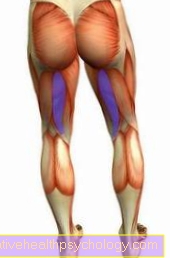What is Oxidative Stress?
Definition / how does oxidative stress arise?
The term oxidative stress was first used by Helmut Sies in 1985 and describes a metabolic situation that is characterized by an excess of reactive oxygen compounds (ROS). These arise in every cell in the so-called Mitochondria, in which cell respiration takes place for energy production.As part of the metabolic processes in the mitochondria, various reactive oxygen compounds can arise, such as the Hydrogen peroxide, Hydroxyl radicals or Superoxide anion radicals.
According to their name, these substances are extremely reactive and interact with many other components of a cell. These processes are described as Oxidation. In a healthy cell, the oxidizing substances, such as the ROS, are in equilibrium with reducing substances, which ultimately leads to a neutralization of their harmful effects.
If this balance is shifted in favor of the reactive oxygen compounds, cell damage occurs. This process is known as what is known as oxidative stress.
causes
The causes for a shift in this balance in the sense of oxidative stress can have various causes. In addition to external factors such as too much UV radiation or pollution in the air, an unhealthy diet and the consumption of alcohol or nicotine can also trigger oxidative stress.
Read more on the topic: Effect of Alcohol - Influence on Various Organs and Healthy Eating
All of these triggers have the same effect that the body converts more energy, be it for the neutralization of toxins or a simple oversupply with unhealthy diet. This increased energy consumption then results in an increased production of reactive oxygen compounds.
Similarly high increases in energy turnover can also be triggered by an active immune defense in the presence of an infection or inflammation, or by extreme sports. The influence of drugs in the development of oxidative stress is also discussed more and more frequently. In particular, certain antibiotics and hormone preparations are suspected.
Read more on the topic: Overtraining
How can one diagnose oxidative stress?
The diagnosis of oxidative stress is based on 3 different pillars. First, a detailed medical history is taken, which includes inquiries about various risk factors, such as an unhealthy diet, the consumption of alcohol or nicotine and many others.
This is followed by a physical examination with determination of the weight and BMI, as well as the examination of the vessels on the basis of pulse controls. In addition, blood pressure and heart rate are measured.
Read more on the topic:
- Obesity
- Underweight
- Malnutrition
Although none of these parameters provide clear evidence of oxidative stress, they can be non-specific signs. The diagnosis only becomes specific through the determination of numerous laboratory parameters such as enzymes, vitamins or certain proteins.
Are there reliable tests + How can you measure oxidative stress?
In the meantime, a very precise measurement of oxidative stress can be carried out by combining a wide variety of laboratory parameters. The measurement of proteins that arise as a result of oxidative stress has shown the most accurate results. Here are especially those Malondialdehyde-modified LDL, a form of cholesterol, and Nitrotyrosine to call. Their accuracy is mainly due to the fact that they are only subject to very slight fluctuations, as is the case, for example, with the determination of enzymes.
In addition to testing proteins that arise as a result of reactive oxygen compounds, their actual counterparts in the reducing system can also be measured. These should be significantly reduced in the case of pronounced oxidative stress. This group includes vitamins C and E, as well as the intracellular Glutathione. Most of the time, trace elements such as selenium or zinc are also determined, as they are an integral part of many enzymes that are active in this context.
Read more on the topic:
- Hypercholesterolemia
- Vitamin deficiency
Symptoms
Since oxidative stress per se is not a disease of its own, no clear symptoms can be assigned to it. Rather, oxidative stress presents itself as a risk factor for many other diseases. These include cardiovascular diseases, diabetes mellitus, neurodegenerative diseases such as Alzheimer's or Parkinson's, but also cancer.
It is also assumed that oxidative stress plays a decisive role in the process of aging. At this point it should be mentioned again that oxidative stress is fundamentally present in every person. This only becomes problematic if a certain amount is exceeded.
Read more on the topic:
- Skin aging
- Skin folds
How does oxidative stress show up on the skin?
Oxidative stress itself leads to damage in the cell, for example to its outer fat layer, but the main effect of oxidative stress is a reduction in the protection and repair systems in the cell. This is also the case in the skin. Damage caused by external factors such as UV radiation can be compensated for less and less, which ultimately leads to faster aging of the skin. Signs of this are an increasingly thinning epidermis (epidermis), a loss of flexibility, drier skin, and a significantly longer regeneration time for the skin in the event of injuries.
Read more on the topic:
- Skin care
- This is how dry skin is treated
- Anti-aging on the skin
- How can you stop the aging process?
Treatment / therapy
Since oxidative stress is based on a balance shift in favor of the oxidative system, in the sense of an increased concentration of reactive oxygen compounds, therapy should be based on strengthening their opponents. These belong to the reducing system, but are often referred to simply as antioxidants to illustrate their role as opponents to the ROS.
The most important antioxidants are vitamins A, C, E and the trace elements zinc and selenium. Its role as a protector against oxidative stress has been proven in numerous studies. However, it remains unclear whether a supplementary intake of these vitamins and zinc actually leads to better protection against oxidative stress. What is clear is that people who lead a healthy lifestyle that includes a balanced diet and exercise do not need to take additional antioxidants. Thus, before taking any dietary supplements, you should first check your own lifestyle.
Read more on the topic:
- Naturopathic detoxification
- Alpha lipoic acid
- Orthomol Immun®
How can I treat oxidative stress through exercise?
Basically, we have to agree with the statement that sport can have a protective effect against oxidative stress. However, this shows a clear dependence on the intensity of the sport practiced.
Organs that have a high energy turnover through cellular respiration, such as the heart, liver and muscles, initially tend to produce reactive oxygen compounds during physical activity. However, it is also inherent in these organs that they can permanently increase their own protective functions against oxidative stress as a result of exercise in order to compensate for the oxidative stress that occurs. It is therefore true that sporting activity can basically increase the protective systems against oxidative stress.
This only becomes critical if sport is carried out very intensively, as the organs can then only partially compensate for the oxygen compounds that arise and there can even be increased oxidative stress. The protective effect of sport is therefore always a question of the level of physical activity.
Read more on the topic:
- Heart rate when exercising
- Anaerobic threshold
- Overtraining
- Endurance sports and nutrition
How can I influence oxidative stress through diet?
To avoid oxidative stress, there should always be enough antioxidants in the body to prevent it. As already mentioned, vitamins A, C and E, as well as the trace elements selenium and zinc, are among the most important representatives of this group. A diet that aims to avoid oxidative stress should therefore contain plenty of these substances. In most cases, however, this can already be achieved by consuming enough vegetables and fruit and no additional vitamin preparations have to be taken.
Read more on the topic: Zinc deficiency and vitamin deficiency
If you still wish to do so, this should be done in consultation with a doctor, as an overdose of vitamins can have serious side effects. The consumption of food that is very high in sugar and fat is not only suspected of being low in antioxidants, but also of promoting the formation of reactive oxygen compounds. It is therefore true that oxidative stress can be influenced very well by a healthy diet, even without having to take supplementary preparations.
Read more on the topic. 5 elements diet
What diseases are related to oxidative stress?
There are numerous diseases that are believed to be related to oxidative stress. First of all, cardiovascular diseases should be mentioned. It is assumed that high oxidative stress leads to increased cholesterol levels (Hypercholesterolemia), Calcification of the vessels (Atherosclerosis) and chronic high blood pressure. Furthermore, oxidative stress is assigned a role in the development of type 2 diabetes mellitus.
However, some neurodegenerative diseases, such as Alzheimer's disease or Parkinson's disease, are also suspected of being triggered by oxidative stress, among other things. In addition, it has been shown that increased oxidative stress is a risk factor for the development of certain types of cancer.





























